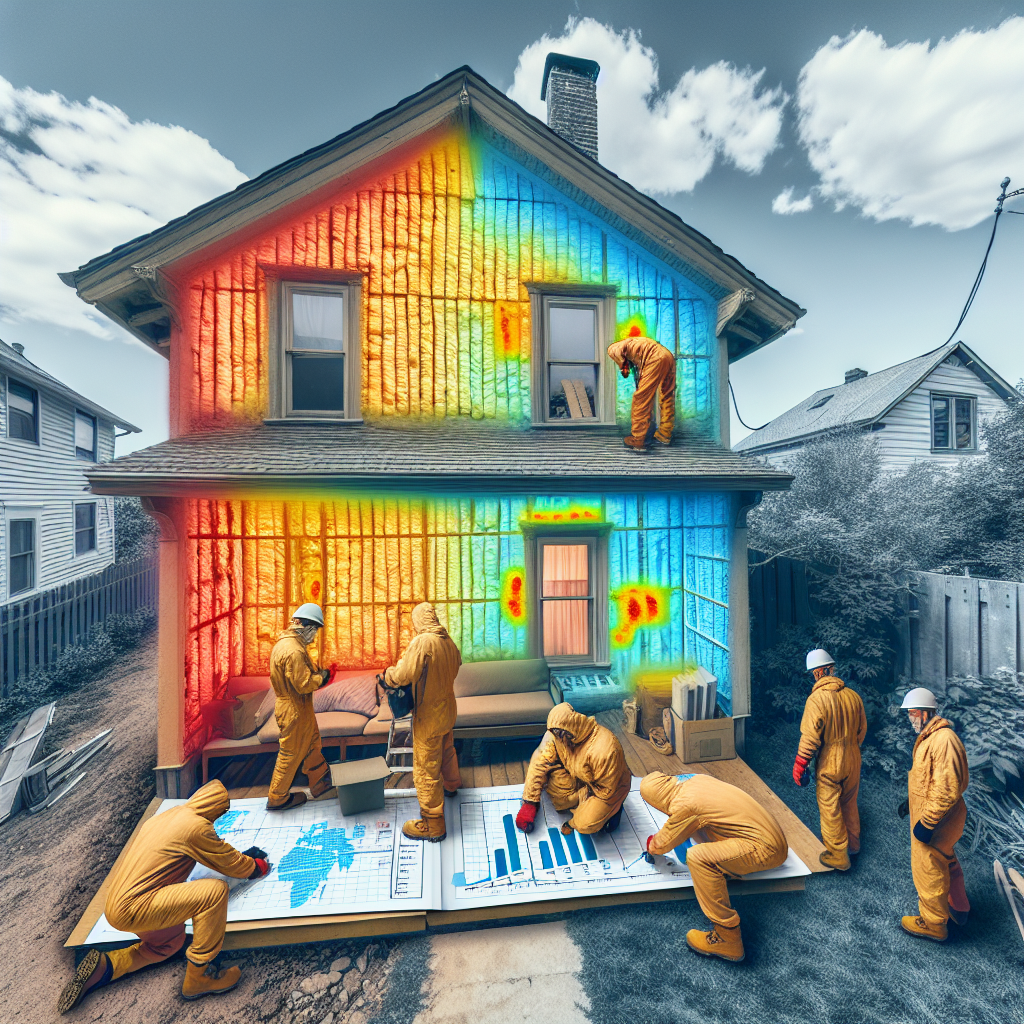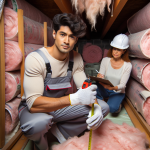Upgrading Home Insulation for Extreme Climates
-
Table of Contents
Upgrading home insulation for extreme climates is a critical step in enhancing energy efficiency, comfort, and overall home durability. In regions experiencing severe temperature fluctuations, whether scorching summers or frigid winters, effective insulation acts as a barrier against external weather conditions, maintaining a stable indoor environment. This not only reduces the strain on heating and cooling systems, leading to significant energy savings, but also contributes to a more sustainable living space by lowering carbon footprints. Modern insulation materials and techniques have evolved to address the unique challenges posed by extreme climates, offering homeowners a range of options to improve thermal performance, moisture control, and air sealing. By investing in high-quality insulation upgrades, homeowners can ensure their living spaces remain comfortable year-round, while also protecting their property from potential weather-related damage.
Benefits Of Upgrading Home Insulation In Extreme Climates
Upgrading home insulation in extreme climates offers a multitude of benefits that extend beyond mere temperature regulation. One of the primary advantages is the significant improvement in energy efficiency. In regions where temperatures can soar to sweltering highs or plummet to bone-chilling lows, maintaining a comfortable indoor environment often requires substantial energy consumption. Enhanced insulation acts as a barrier, reducing the amount of heat that escapes during winter and preventing excessive heat from entering during summer. Consequently, homeowners can expect a noticeable reduction in their energy bills, as heating and cooling systems do not have to work as hard to maintain a stable indoor temperature.
Moreover, upgrading insulation contributes to a more sustainable living environment. By decreasing the reliance on heating and cooling systems, the overall carbon footprint of a household is reduced. This is particularly important in the context of global efforts to combat climate change. Improved insulation materials, such as spray foam or rigid foam boards, often have higher R-values, which measure their resistance to heat flow. These materials not only provide better thermal performance but also have a longer lifespan compared to traditional insulation options, thereby reducing waste and the need for frequent replacements.
In addition to energy efficiency and sustainability, enhanced insulation significantly improves indoor comfort. Extreme climates can lead to uncomfortable living conditions, with rooms that are either too hot or too cold. Upgraded insulation ensures a more consistent indoor temperature, eliminating cold drafts in the winter and hot spots in the summer. This creates a more pleasant living environment, which can positively impact the overall well-being of the occupants. Furthermore, better insulation can also contribute to improved indoor air quality. By sealing gaps and cracks, it prevents outdoor pollutants, allergens, and moisture from entering the home, thereby creating a healthier indoor environment.
Another notable benefit of upgrading home insulation is the potential increase in property value. Homes with high-quality insulation are often more attractive to potential buyers, particularly in regions known for extreme weather conditions. Prospective buyers are likely to appreciate the long-term cost savings associated with lower energy bills and the enhanced comfort that comes with superior insulation. As a result, investing in upgraded insulation can yield a higher return on investment when it comes time to sell the property.
Additionally, improved insulation can also provide soundproofing benefits. In extreme climates, homes are often built with materials that can amplify external noises, such as wind or heavy rain. Upgraded insulation materials can help to dampen these sounds, creating a quieter and more serene indoor environment. This is particularly beneficial for homes located in noisy areas or for individuals who value peace and quiet.
Lastly, it is important to consider the potential for government incentives and rebates when upgrading home insulation. Many regions offer financial incentives to encourage homeowners to improve their energy efficiency. These incentives can help offset the initial cost of insulation upgrades, making it a more affordable investment. By taking advantage of these programs, homeowners can further enhance the cost-effectiveness of their insulation improvements.
In conclusion, upgrading home insulation in extreme climates offers a wide range of benefits, from improved energy efficiency and sustainability to enhanced indoor comfort and increased property value. By investing in high-quality insulation materials, homeowners can create a more comfortable, healthy, and cost-effective living environment while also contributing to broader environmental goals.
Top Insulation Materials For Extreme Weather Conditions

When considering the upgrade of home insulation for extreme climates, it is essential to select materials that can withstand the harshest weather conditions. The choice of insulation material can significantly impact the energy efficiency, comfort, and durability of a home. Therefore, understanding the top insulation materials suitable for extreme weather conditions is crucial for homeowners aiming to enhance their living environment.
One of the most effective insulation materials for extreme climates is spray foam insulation. This material is known for its excellent thermal resistance and air-sealing properties. Spray foam insulation expands upon application, filling gaps and creating a continuous barrier against air infiltration. This characteristic makes it particularly effective in preventing heat loss during cold winters and heat gain during hot summers. Additionally, spray foam insulation has a high R-value per inch, which measures its thermal resistance, making it a superior choice for extreme weather conditions.
Another highly recommended insulation material is rigid foam board insulation. This type of insulation is available in various forms, including expanded polystyrene (EPS), extruded polystyrene (XPS), and polyisocyanurate (PIR). Rigid foam boards are known for their high insulating value and moisture resistance. They are particularly effective in reducing thermal bridging, which occurs when heat transfers through the building’s structural elements. By minimizing thermal bridging, rigid foam board insulation helps maintain a consistent indoor temperature, regardless of external weather conditions.
In addition to spray foam and rigid foam board insulation, fiberglass insulation remains a popular choice for extreme climates. Fiberglass insulation is composed of fine glass fibers and is available in batts, rolls, and loose-fill forms. It is known for its affordability, ease of installation, and fire-resistant properties. While fiberglass insulation may not have the same air-sealing capabilities as spray foam, it still provides excellent thermal resistance. Moreover, advancements in fiberglass technology have led to the development of high-density fiberglass batts, which offer improved performance in extreme weather conditions.
Cellulose insulation is another viable option for homeowners seeking to upgrade their insulation for extreme climates. Made from recycled paper products, cellulose insulation is treated with fire-retardant chemicals to enhance its safety. It is available in loose-fill and dense-pack forms, making it suitable for various applications. Cellulose insulation is known for its ability to reduce air infiltration and provide excellent thermal resistance. Its eco-friendly nature also appeals to environmentally conscious homeowners. Furthermore, cellulose insulation has the added benefit of being able to absorb and release moisture, which can help regulate indoor humidity levels.
Mineral wool insulation, also known as rock wool or slag wool, is another top contender for extreme weather conditions. This insulation material is made from natural rock or industrial by-products and is available in batts and loose-fill forms. Mineral wool insulation is highly resistant to fire, moisture, and pests, making it a durable and long-lasting option. Its high density and excellent thermal resistance make it particularly effective in extreme climates. Additionally, mineral wool insulation provides superior soundproofing, enhancing the overall comfort of a home.
In conclusion, upgrading home insulation for extreme climates requires careful consideration of the available materials. Spray foam insulation, rigid foam board insulation, fiberglass insulation, cellulose insulation, and mineral wool insulation each offer unique benefits that can enhance a home’s energy efficiency and comfort. By selecting the appropriate insulation material, homeowners can ensure their homes remain resilient against the challenges posed by extreme weather conditions.
Cost-Effective Strategies For Insulating Homes In Harsh Climates
Upgrading home insulation for extreme climates is a crucial step in ensuring energy efficiency and comfort. In regions where temperatures can plummet to frigid lows or soar to scorching highs, effective insulation becomes indispensable. However, the cost of such upgrades can be a significant concern for homeowners. Fortunately, there are several cost-effective strategies that can be employed to enhance home insulation without breaking the bank.
To begin with, one of the most accessible and affordable methods is to improve attic insulation. The attic is often the primary source of heat loss in a home, and enhancing its insulation can yield substantial energy savings. Homeowners can opt for materials such as fiberglass batts, cellulose, or spray foam. Fiberglass batts are relatively inexpensive and easy to install, making them a popular choice. On the other hand, cellulose, made from recycled paper products, offers an eco-friendly option with excellent thermal performance. Spray foam, while initially more costly, provides superior air sealing and insulation properties, making it a worthwhile investment in the long run.
In addition to attic insulation, sealing air leaks throughout the home is another cost-effective strategy. Air leaks can significantly undermine the effectiveness of insulation, leading to increased energy consumption and discomfort. Homeowners can use caulk and weatherstripping to seal gaps around windows, doors, and other openings. Moreover, installing door sweeps and outlet gaskets can further reduce drafts and enhance overall insulation. These measures are relatively inexpensive and can be completed as DIY projects, making them accessible to most homeowners.
Furthermore, upgrading windows can also contribute to better insulation in extreme climates. Single-pane windows are notorious for their poor insulating properties. Replacing them with double-pane or triple-pane windows can drastically improve thermal performance. While the initial investment may be higher, the long-term energy savings and increased comfort make it a cost-effective solution. For those on a tighter budget, adding storm windows or applying window film can provide an additional layer of insulation at a fraction of the cost.
Another effective strategy is to insulate walls and floors. While this can be more challenging and expensive than attic insulation, it is essential for homes in extreme climates. One cost-effective approach is to use blown-in insulation, which can be installed in existing walls without the need for extensive renovations. This method involves drilling small holes in the walls and blowing in insulation material, such as cellulose or fiberglass. For floors, especially those above unheated spaces like basements or crawl spaces, adding rigid foam insulation can help prevent heat loss and improve overall energy efficiency.
Moreover, utilizing thermal curtains and blinds can enhance insulation and reduce energy costs. These window treatments are designed to trap air and create a barrier against temperature extremes. They are relatively inexpensive and can be easily installed by homeowners. Additionally, they offer the added benefit of improving privacy and reducing noise pollution.
Lastly, it is essential to consider the role of proper ventilation in maintaining an insulated home. While it may seem counterintuitive, adequate ventilation is crucial for preventing moisture buildup and ensuring the longevity of insulation materials. Installing vents in attics and crawl spaces, as well as using exhaust fans in kitchens and bathrooms, can help maintain a healthy indoor environment and protect insulation from damage.
In conclusion, upgrading home insulation for extreme climates does not have to be prohibitively expensive. By focusing on cost-effective strategies such as improving attic insulation, sealing air leaks, upgrading windows, insulating walls and floors, utilizing thermal curtains, and ensuring proper ventilation, homeowners can achieve significant energy savings and enhanced comfort. These measures not only contribute to a more sustainable living environment but also provide long-term financial benefits.
Read more about Home Insulation
- Types of Home Insulation
- Benefits of Home Insulation
- Choosing the Right Insulation for Your Home
- Common DIY Home Insulation Mistakes
- Insulation for Different Areas of Your Home
- Signs of Poor Home Insulation
- Home Insulation ROI (Return on Investment)
- How to Improve Home Insulation without Breaking the Bank
- Maintaining and Updating Home Insulation








